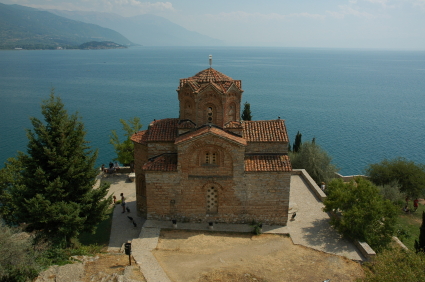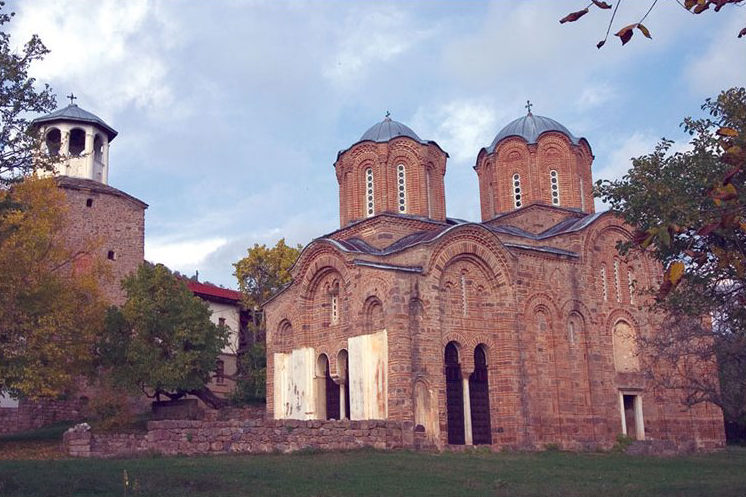The beauty of Macedonia! [PART THREE]
 •
by
•
by DarkoDimovski1

Church Sv.Sofia
The cathedral church of St.Sofia is one of the most impressive medieval buildings in the city of Ohrid and the seat of the autocephalous Ohrid Archibishopric. It was build on the foundations of an early Christian basilica by the Archbishop Leon between 1035-1056. The fresco paintings comprise a gallery of medieval art from the first half of the 11century up to 14century.

St. Jovan Kaneo
This monastery was build at the end of the 13century. The architecture of the church is a perfect combination of Byzantine and Armenian elements. It is located in one of the most beautiful spots of the Ohrid coast, to the west of the old city, on a massive rock above the fishing settlement of Kaneo. It offers a wonderful view to the southeast and northeast side of the lake. The church is build of stone in its lower part and of chipped limestone blocks and horizontal layers of red bricks above it. This church is a symbol of Ohrid.

The Robevtsi House
This house is a masterpiece of Macedonian traditional urban architecture. It is located in the Old City of Ohrid and is named after one of the most famous city families - The Robevtsi, mentioned for the first time in written records from 1379. The house was build in 1827, while the carved wooden ceilings and the rest of the interior were made by the famous Mijak carvers. Today it houses the Ohrid City Museum.[/b]

The monastery of St.Naum
This monastery is located by the southernmost part of Lake Ohrid, close to the border of Albania. The monastery was build upon a high and steep cliff above the lake. The original church, dedicated to the archangels Ss. Michael and Gabriel, was build in c.900 by the great educator St.Naum of Ohrid. St Naum of Ohrid was a disciple of Ss. Cyril and Methodius and a contemtorary of St. Clement of Ohrid. After his death in 910, St Naum was buried within the monastery. The legend says the one can still hear the saint's heart throbbing if one presses one's ear against his tombstone. Between 10 and 13 centuries, the Church of St. Naum was destroyed. In the 16 century, a new church was build on the foundations of the old. The wooden gate is presumed to be 1100 years old and a part of the old monastery complex. Above the gate there is a mosaic presenting a bear harnessed to a plough.

The Springs of the Drim River
The water from Prespa Lake finds its way under the Galichitsa Mountain into the Lake of Ohrid. The bubbling waters of the springs are renowned for the emerald colour they emanate. The spring area is of dispersed type and consists of 46 springs, of which 30 are underwater springs and 16 are lakeside springs. The capacity of the springs is 6.5-10m qubic per second, which is 25% of the total water intake of the lake. The water springs from enormous dephts with temperature ranging between 10-12C throughout the year. The springs are located within the National Park Galichitsa and under UNESCO protection.

The Church of St. George in the Village of Kurbinovo
It is located three kilometers from the village of Kurbinovo in the foothills of the Baba mountains, near the Prespa Lake. The church is widely renowned for its splendid fresco paintings that decorate the whole of the interior, painted as early as 1191 during the reign of the Byzantine rulers of the Kommenid dynasty. The fresco compositions make Kurbinovo one of the masterpiece of Byzantine art. The canonic style of Constantinople is not preserved and a very specific domestic style of the local masters is predominant. The linear expression of the Kommenid style in the art of fresco painting was not only fully absorbed by the domestic fresco painters but also further developed into an almost baroque playfulness. The most famous fresco is the depiction of Archangel Garbiel.

St. Archagel Monastery
It is located in Prilep, build in 1371. Nowadays it is the home of a thriving monastic community. The monastery compex consists of a church dedicated to St. Archangel and the monastery premises were build in the 19Century by Prilep merchants. Remains of ancient buildings have been found in the courtyard and beneath the porch and the naos of the monastery.

Lesnovo Monastery
The Osogovo Mointain also treasures the monastery dedicated to St. Archangel Michael and the famous hermit Gavril of Lesnovo. Build at an altitude of 870m, it is also known among the people as the Lesnovo Monastery. The benefactor of the monastery was Jovan Oliver, who had it build on the remnants of an ancient basilica in 1341. The most important period of its development was during the 15 century(marked by the reign of Czar Dushan, who appointed the monastery a seat of the newly created Zletovo Episcopate). The most interesting detail regarding the frescoes in the monastery are the negroid characteristics of St. Moses of Ethiopia, also known as Murin the Dark One, and St. Barbarus, who lived as a pirate and died after his conversion in 1403.

The Monastery of St. Joachim of Osogovo
The monastery of St.Joachim of Osogovo is located in the vicinity of Kriva Palanka, at an altitude of 825m. The history of the monastery begins in 12century and is related to the life of the hermit St. Joachim of Osogovo who spent his ascetic life in a cave near the monastery. The monastery complex concists two temples, the big church dedicated to St. Joachim and the smaller church dedicated to The Holy Mother of God. The big church is a three-nave basilica with twelve domes, build of chipped limestone. The grave of the patron-saint lies within its premises. The monastery of St. Joachim of Osogovo was also the residence of Joachim Krchovski, a priest, a teacher, pedagogue, and significant author from the 19century

The monastery of the Holy Mother of God Eleousa
This monastery was build in medieval times, during the Byzantine period. It is located seven kilometers to the west of the city of Strumica, near the village of Velusa. This monastery church dedicated to the Virgin Eleousa is first mentioned in the Letters (Grammatas) of the Byzantine emperor Alexius I Komnenos in 1085. The architecture of the church is unique and stands as an example of the highest achievments of sacred Byzantine architecture and art in the 11 century. The fresco paintings, with symbolic iconographic presentations from the Old and the New Testament, dates back to 1085. The church nowadays is a treasure-house of invaluable works of art.

Stobi
The ancient city of Stobi, settled in the fertile valley north-west of Negotino, was an important crossroads of old civilizations. According to archeological findings, it dates from the 2century BC. Stobi expirianced its most remarkable growth during the 3 and 4 centuries. In Roman times, the city was a complex urban settlement with a number of stores, warehouses, baths, blacksmiths, wool-processing plants, a graveyard, a wide city square, and an ancient theathe which was later turned into an arena. During the early Christian period, the city abounded with churches, basilicas, and a baptistery. Recently, new findings have been made in the Roman Forum.

Vardar Rid
This locality is close to the northern periphery of the city of Gevgelija. In ancient times, this region was known as Amphaxitida and funcioned as an independent administrative unit inhabited by ancient Macedonians as a separate ethnic group. At the southern edge of the city there are remnants of a fortification, along with other objects, dominated by the ruins of a monumental public buildings from the 5 century BC. This locality is especially interesting for its numismatic findings, consisting of a great variety of coins issued by all the Macedonian rulers, such as the silver tetredrachmae, coins from the time of the first Macedonian king Alexander. There are also coins from the time of a Paionian tribe known as the Oreski(late 6-5 centuries BC). This is one of the most complex archaeological sites in Macedonia, with intricate stratigraphy and various cultural artifacts from different epochts.
For the end please shout this:
The beauty of Macedonia[PART THREE]
http://tinyurl.com/6z85fhp


Comments
The beauty of Macedonia[PART THREE]
http://tinyurl.com/6z85fhp
Кој сака нека мавне шаут!
Одлично брат, сметам дека бар 5 можеш овакви да направиш !
Поздрав !
В+С
na stobi ne se gleda mnogu ubavo slikata....i na vardarski rid najdi nekoja druga....a stavi ja i heraklea 🙂
Хераклеа ја имаше во 1 дел, а слики ќе побарам подоцна, ја праев статијава саат време..
v+s
Поделба на 120 здравје за секого! http://www.erepublik.com/en/article/-1-1799003/1/20
Bravo za statijava... top 😉
Bravo za statijava... top
Odlicna statija, vaka treba da ja promovirame Makedonija.
Sv.Joakim Osogovski najubav manastir 🙂 v+s super statija
o/
50 vote sub od porano
o7
vote! a sub od porano
o//
vrati
MIGHTY MACEDONIA AND ITS ALLIES!![MK][EN][INT]
http://www.erepublik.com/en/article/mighty-macedonia-and-its-allies-mk-en-int--1798014/1/20
statijava e top
Are you guys Christian Orthodox? Nice pics anyway.
38Megalexandros
Are you guys Christian Orthodox? Nice pics anyway.
Is this some kind of joke?
you dont know that we are orthodox ?
beautiful places to see. maybe one day.
Браво Даре имаш целосна подршка од мене !
http://www.erepublik.com/en/newspaper/emacedoniatimes-257056/1
Vrati 😁
o7
Plzzz. Write to me! I'm only waiting for you: https://www.youtube.com/redirect?q=%6e%61%6b%65%64%2d%67%69%72%6c%73%2e%6f%6e%6c%69%6e%65%2f%6b%6b%2f%78%6b%44%57%43%39%3f%73%6f%75%72%63%65%3d%65%72%65%70%75%62%6c%69%6b%26%61%64%5f%63%61%6d%70%61%69%67%6e%5f%69%64%3d1798613